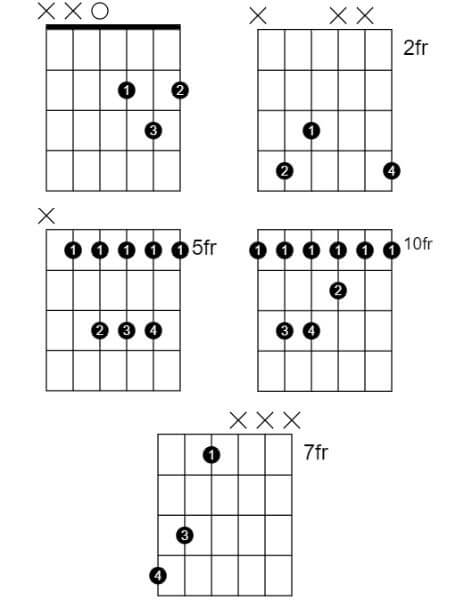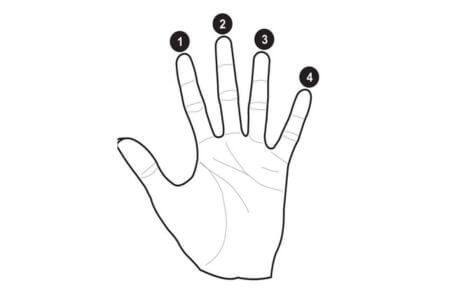5 Ways to Play the D Chord on Guitar
The D chord is one of the first and most important chords you should learn on guitar. Fortunately, the most basic form of the D chord is easy to learn, and most new players can fret it right away. Plus, if you learn to play D major, you’ll be able to use it in countless songs across many styles of music.
One of the best things about the guitar is that it allows for many different voicings of the same chord. Each new voicing provides a slightly different sound and sits on a different region of the fretboard. Trying out multiple voicings of the same chord will give you more options for composing, improvising, or just playing around.
For those who just want to see the D chord shapes right away, I’ll include them below for your reference. If you want to learn some of the theory behind the D chord, as well as some general chord-playing advice, then read on!

How Do You Read a Chord Chart?
Chord charts are a common way for guitarists to illustrate and share chord shapes. Basically, the grid you see represents the frets (horizontal) and strings (vertical) of the guitar. The black dots show you what notes need to be fretted for the chord, while the numbers inside those dots are fingering suggestions.
As far as the fingerings go, each number corresponds to one of your fretting-hand fingers. “1” is your index, “2” is your middle, “3” is your ring, and “4” is your pinkie finger. Refer to the diagram below if you ever get confused:

There are a couple of other things you should pay attention to in these chord charts. For one, always check the upper-right side of the chart to make sure you’re starting at the right fret. You can see that the easiest D major chord shape starts at the 1st fret (no number indicated means fret 1), but the first D major barre chord actually starts at the 5th fret!
Also pay attention to the X’s and O’s at the top of the charts. These indicate whether a string should sound (O) or not (X). Anywhere you see an X, you need to be sure you’re not accidentally playing that string. You either need to mute those strings or simply avoid playing them while you pluck the correct ones.
Finally, you might have noticed that some of the D chords are characterized by their position on the fretboard. Your left-hand position is determined by your index finger’s location.
If your index is around the first fret, you’re in first position (the most comfortable position for most players). If your index finger is around the seventh fret, then you’re in seventh position, and so forth.
What Is a Chord?
A chord can be defined as a harmonic set of notes that are heard as if sounding simultaneously. Typically, chords consist of three notes: a root note, and intervals of a third and a fifth above the root. In music theory, this group of three notes is called a triad.
In the case of a D chord, these notes are D, F#, and A. If you examine all 5 of the chords displayed above, you’ll notice that none of them contain notes other than D, F#, and A.
So how can we strum all six strings (as in “D Major Barre #2” above) if a triad is only supposed to be three notes? The answer is that some of these notes are doubled or even tripled.
You’ll notice that most of the D chords above play multiple D’s in the same chord. That’s because the root note is the one most harmonically suited to being doubled in a triad. In other words, it just sounds good to hear a bunch of D’s in a D chord!
However, D chords are delicate things! If you change a single note—for instance the F# to a plain old F—then you get a completely different chord (a D minor chord). You also get a new chord if you add any note outside the triad. There’s nothing wrong with spicing up a D chord, of course, but you’ll no longer be playing D major, strictly speaking.
How Do You Play Barre Chords?
You probably noticed that the two shapes above require a barring technique.
Barre chords require you to lay your index finger across multiple strings. This can create a great deal of left-hand tension. You might not be able to barre at all, especially if you’re new to guitar playing. So, how do you go about learning these challenging chords?
The first thing to realize is that barre chords will never get easier if you avoid them. Like anything difficult, barring competence only comes with lots of practice. If you feel like barre chords are holding you back, I suggest you take some time every day—even just a few minutes—and practice your barres.
Steel-string acoustic guitarists in particular will need to spend a lot of time working on barre chords. Their strings are strung at a higher tension than classical or electric guitars, making barring more difficult.
If you’re looking for more help with barre chords, you’ll find this post extremely useful.
The good news is that once you master barre chords, you can use the shapes above to play any chord on the fretboard. All you need to know is the root note on the low E string or low A string.
The two chord shapes above work because they each start with a D on top. Move each shape down two frets and you get a C chord (because C is two half-steps below D). Move up two steps and you get an E chord. I’m sure you can figure out the rest!
Common Chord Progressions?
The best part of being able to play a D chord is that you can use it in any number of songs. Many of these songs tend to use the same chord progressions, so it helps to be aware of some popular ones. In fact, learning a common chord progression is a bit like learning a bunch of songs all at once!
Here are some chord progressions using the D chord you’re likely to encounter:
G – D – G – D
D – G – A
A – D – E
G – C – D
Em – C – D – G
How Do You Speed Up Chord Changes?
Changing chords is one of the hardest things to do on the guitar. It’s usually easy enough to strum along once we’re on the right chord, but jumping around with the left hand can be a hassle.
Fortunately, you can do a lot to improve your chord changes. The key is to recognize exactly what’s tricky about a given change, then isolate and solve the problem.
Regardless of chords you’re working with, I can tell you right now that you should practice with your fretting hand alone. Strumming or plucking will only distract you from the real challenge. It may feel strange to practice guitar without making any sound, but I guarantee that it’s the fastest way to improve your changes.
One of the best methods I recommend for left-hand-alone chord practice is to shape the first chord, relax my hand, then shape the second chord, and repeat.
Really concentrate on the feeling of each chord shape, almost as if you’re meditating on it. Go as slow as you can manage. Before long, your fingers will have memorized both shapes and have the ability to switch quickly between them.
Once you’ve worked on your left hand for a while, you can bring your right hand back in. You’ll be amazed at how much easier the change feels!
For even more advice on changing chords with ease, you’ll definitely appreciate this post.
Conclusion
I hope the all 5 of the D chord shapes above will prove useful to you. You’re probably already familiar with one or two of them, but knowing as many shapes as possible will only make you a better rounded guitarist.
Some of these chords might feel hard at first, but if you put in a little bit of effort every day, you’ll be sure to conquer them in no time. If you’re curious, you can find my general practice advice right here.
Best of luck with your new D chords!
Are you looking to upgrade your gear or browse some awesome guitar learning materials? Check out my recommendations page to see all my favorite stuff.
Want to streamline your fingerstyle guitar progress? I just released my new ebook, Fingerstyle Fitness, which presents 10 easy exercises to quickly develop your fingerstyle chops. Grab it today!